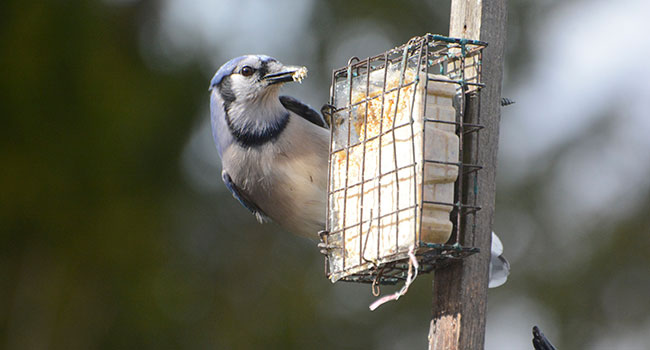
Place your feeders so they’re not under dense cover as predators will sneak up on them. Placing them in the open allows the birds to flee to safety
 The last few days have been really exciting bird-wise as hawks, ducks, geese, loons and many small passerines (e.g. kinglets, sparrows and finches) are on the move.
The last few days have been really exciting bird-wise as hawks, ducks, geese, loons and many small passerines (e.g. kinglets, sparrows and finches) are on the move.
Winter is here whether we like it or not and those hardy northern birds have decided it’s time to migrate. North winds and cool nights have caused an influx of tens of thousands of birds into our area.
Throughout much of eastern Canada and the United States, evening grosbeaks (which have been virtually absent for several years) are here in good numbers. The other day, 58 stopped in my yard to feed.
Redpolls (another small finch) arrived in late October to join the pine siskins and goldfinches that were already here. Blackbird flocks are sometimes huge here in the fall – I’ve recently seen 750 grackles in a single flock. Juncos and white-throated, song, fox, American tree and white-crowned sparrows are here in great numbers as well.
All this means that if you haven’t already, you should get your feeders out and filled. But before you do, here are a few tips:
- Clean your feeders with a light bleach and water. Once they’re totally dry (and don’t smell like chlorine), fill them and put them up.
- How many feeders should you put out? It’s up to you but be aware that one type of feeder doesn’t serve all birds – different birds have different feeding preferences and like different foods.
- Use any seed mix you like. I favour different mixes that include as little millet as possible and as much sunflower as you can afford. I find the smaller black sunflower is favoured by more birds but they certainly will eat the larger sunflower seed as well. I add mixed seed to an all-round treat that most birds like. On the ground I spread rolled/cracked corn as the sparrows, doves and cardinals thrive on it and it’s very inexpensive. Finches like Niger seeds in tubular feeders. And don’t forget the woodpeckers – put out suet blocks to serve their palate.
- Choose a spot that gives you a clear line of sight to your feeder(s) so you can enjoy watching the birds.
- Place your feeders so they’re not under dense cover as predators will sneak up on them and take some for dinner. Placing them in the open, one to two metres from heavy cover, allows the birds to flee to safety but is just far enough that squirrels have trouble leaping onto them from adjacent branches. Set them no less than 1.3 metres off the ground, again so squirrels can’t jump up on them.
- Feeding birds are rarely at ease and so flush easily and often. Don’t place feeders between one and two metres of the house as the birds may fly into your windows and perish. It’s okay to have window-ledge or window-mounted feeders as the birds are right beside the window and if they fly off suddenly, they can’t gain enough momentum to hurt themselves should they hit the window.
- If you have large areas of glass, hang something on the inside (e.g. light curtains or blinds) to prevent bird strikes. Also consider installing patterns on your windows to protect birds (visit https://flap.org/ for some great tips and ideas).
- If you have a cat, please keep it indoors. And no, cats do not need to be outside – they do just fine if kept indoors. Many municipalities have bylaws that make it unlawful to let your cats roam at large. This is an important consideration since billions (yes, billions) of birds, mammals, reptiles and amphibians are killed annually by family and feral cats in North America. I hope all municipalities pass these bylaws as the impact to native species is so devastating and unnecessary!
Okay, you’re ready. The feeders are up and the birds are here – so let’s sit back and enjoy the show!
Geoff Carpentier is a published author, expedition guide and environmental consultant. Visit Geoff online at www.avocetnatureservices.com, on LinkedIn and on Facebook.
The views, opinions and positions expressed by columnists and contributors are the author’s alone. They do not inherently or expressly reflect the views, opinions and/or positions of our publication.
